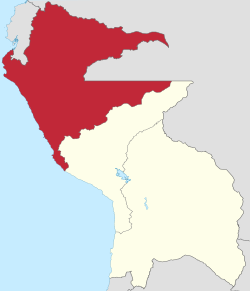Republic of North Peru
Republic of North Peru República del Norte del Perú | |||||||||
|---|---|---|---|---|---|---|---|---|---|
| 1836–1839 | |||||||||
 North Peru within the Peru–Bolivian Confederation | |||||||||
| Capital | Lima | ||||||||
| Government | Presidential republic within a confederation | ||||||||
| President | |||||||||
• 1837–1838 | Luis José de Orbegoso | ||||||||
• 1838–1839 | José de la Riva Agüero | ||||||||
| History | |||||||||
| 11 August 1836 | |||||||||
| 28 October 1836 | |||||||||
| 30 July 1838 | |||||||||
| 25 August 1839 | |||||||||
| |||||||||
| Today part of | Peru Brazil Colombia Ecuador | ||||||||
The Republic of North Peru was one of the three constituent republics of the short-lived Peru–Bolivian Confederation of 1836–1839.
North Peru was one of two states—the other being
The Confederation came to an end three years later after continuous border wars with Argentina and Chile in the War of the Confederation, and after a chaotic civil conflict between north and south Peruvians. In August of 1839, Agustín Gamarra declared the Confederation dissolved; as a result, South Peru and North Peru reverted to being a unified Republic of Peru.
History
Background
After political instability in Peru and a coup d'état in 1835, a civil war broke out between newly self-declared president Felipe Santiago Salaverry and constitutional president Luis José de Orbegoso, who allowed Bolivian president Andrés de Santa Cruz to send his troops through the Peruvian border.[2] After the latter's triumph in 1836, assemblies were soon established to make way for the creation of the Confederation, an idea that had been floating around since the era of independence.
Establishment
A constituent assembly known as the Huaura Assembly was held from August 3 to 24, 1836, and featured representatives from
Provided, then, with all the legal elements granted by the assemblies of the three states, Santa Cruz decreed the establishment of the Peru-Bolivian Confederation, by decree given in Lima on October 28, 1836.
Development and dissolution
The Confederation generated resistance among several groups in both countries, which resented the dilution of national identities, and also among neighbouring countries. An important number of Peruvian politicians who opposed the Confederation, such as Agustín Gamarra and Ramón Castilla, fled to Chile where they received support, leading to the War of the Confederation.[3][10]
After a trade war, the
South Peru was
During this time, the Confederation's stability collapsed, as by September, Peru (i.e. North and South Peru) was under the de jure control of seven different presidents at one time, of which six claimed control over North Peru (with the exception of Pío de Tristán in South Peru): Santa Cruz, who was the Supreme Protector; Gamara, the restorationist president; Orbegoso, leader of the secessionist North Peruvian state; José de la Riva Agüero, who replaced Orbegoso, being appointed by Santa Cruz; Domingo Nieto, in the north; and Juan Francisco de Vidal in Huaylas.[21]
Santa Cruz occupied Lima on November 10, ending the siege in Callao, but left for the north, where the restaurateurs were located. He was defeated in the Battle of Yungay on January 20, 1839, and thus, the Confederation was dissolved,[19] with Gamarra announcing its dissolution on August 25.[22] The Confederate defeat led to the exile of Santa Cruz, first to Guayaquil, in Ecuador, then to Chile, and finally to Europe, where he died.
Government
From 1837 until the
- First president: General Luis Orbegoso(21 August 1837 – 30 July 1838). He declared secession of the Republic of North Peru from the Peru-Bolivian Confederation on 30 July 1838 but continued as Provisional President until 1 September 1838
- Second president: General José de la Riva Agüero (11 August 1838 – 24 January 1839)
See also
- Peru-Bolivian Confederation
- War of the Confederation
References
- Congress of Peru. 1 May 1837.
- ^ Basadre 2014, p. 93–115.
- ^ a b Tamayo 1985, p. 253.
- ^ Basadre 2014, p. 119.
- ^ Basadre 2014, p. 119–121.
- ^ Basadre 2014, p. 121.
- ^ Tamayo 1985, p. 254.
- ^ Basadre 2014, p. 122.
- ^ Basadre 2014, p. 124–125.
- ISBN 9972401499.
- ^ a b c Tamayo 1985, p. 255.
- ^ Basadre 2014, p. 131.
- ^ Avila Echazú, Edgar (14 April 2011). "La anexión e incorporación de Tarija a Bolivia". Tarija200 (1). Archived from the original on 16 June 2020.
- ^ Basadre 2014, p. 133.
- ^ Basadre 2014, p. 136.
- ^ Basadre 2014, p. 137.
- ^ Basadre 2014, p. 138.
- ^ Basadre 2014, p. 139.
- ^ a b Tamayo 1985, p. 256.
- ^ Basadre 2014, p. 142.
- ^ Basadre 2014, p. 145.
- ^ Ortiz de Zevallos Paz-Soldán, Carlos (1972). Archivo diplomático peruano (in Spanish). Vol. 9: Confederación Perú-Boliviana (1835-1839). Ministerio de Relaciones Exteriores del Perú.
Bibliography
- ISBN 978-612-306-353-5.
- Tamayo Herrera, José (1985). Nuevo Compendio de Historia del Perú. Editorial Lumen.


